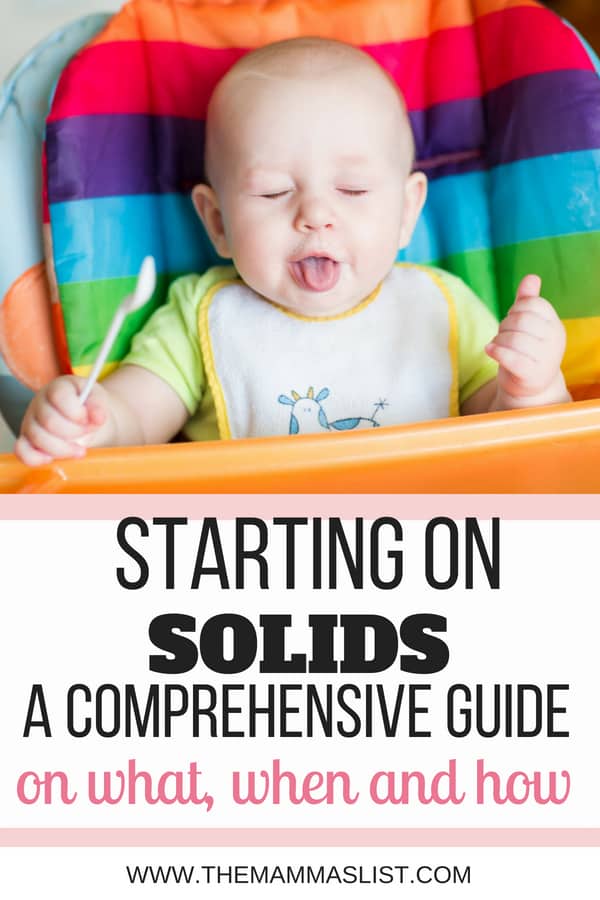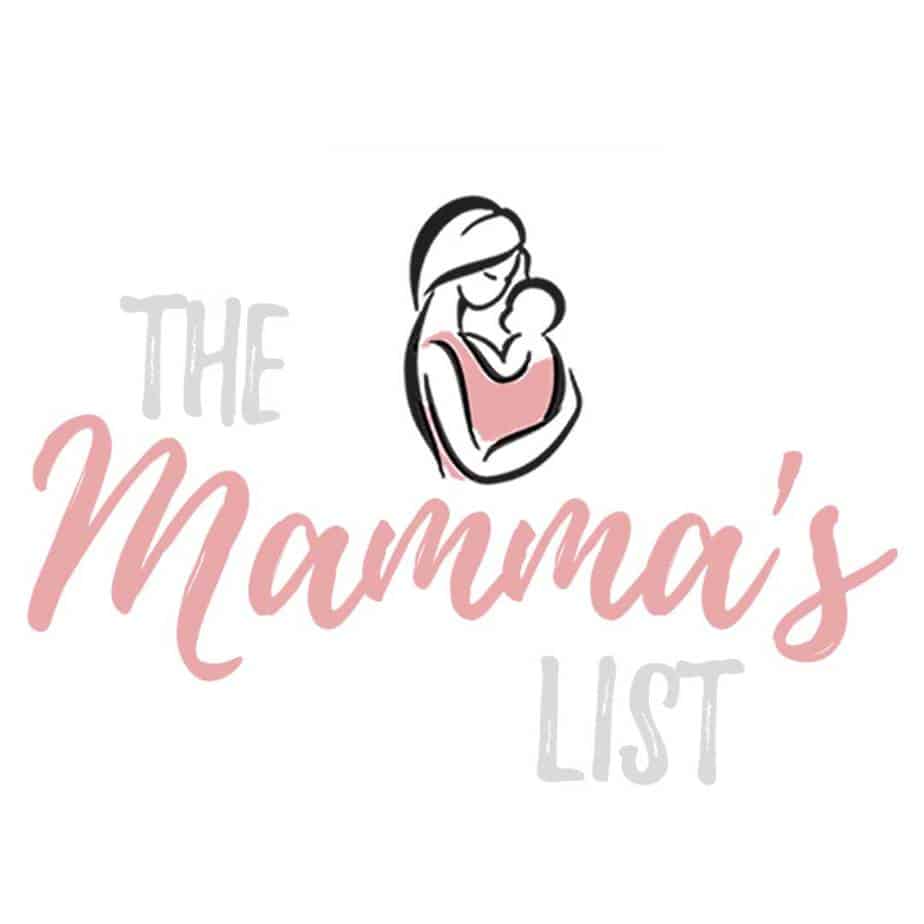How to start solids: detailed advice on the what, when & how of introducing baby food
How to start solids with an EBF baby: tips on first baby foods and when to begin
One of the biggest milestones in your baby’s first year is introducing solid foods, which many people also hope results in more sleep for mamma!
**Please note, that there are no studies that prove introducing solid foods results in more sleep. GI disruption associated with new foods can actually cause more night waking. Don’t introduce solids before four to six months in hopes of getting more sleep. However, if your baby is developmentally ready for solids – you’re in the right spot.
I know that this step can come with a lot of anxiety since you’ve been relying on breastmilk for nourishment thus far. To compound the stress, there is contradicting advice on when introducing solids is best, what baby’s first food should be, and how much they should get. (Important reminder: this article is not only for exclusively breastfeeding moms. However, since I’m the author and that was my experience, I’m telling you how we did it.) This should help anyone prepare to introduce solids to their baby, whether you breastfeed or use formula.
With all these variables it’s no wonder you may not feel there is a clear-cut path to solid food. Have no fear, this post is a comprehensive guide to introducing solids. You’ll find information on what foods are best (many!) how to ensure baby gets the right nutrients, as well as when to begin! I also cover some of the common challenges when introducing solids, like baby constipation and allergies, so let’s dive in.
This post probably contains affiliate links. That means if you buy something using one of my links I may receive a small commission – at no additional cost to you! How cool is that? It’s kind of boring, but feel free to read my full disclosure if you want more info.
At what age should you begin introducing solids
One of the first questions new moms ask when thinking about introducing solids is WHEN to start baby food. The question of the best age to begin solid food is even more complicated because many pediatricians answer by saying “between four and six months.”
The recommendation I’ll provide here is about six months, based on the recommendation from the American Academy of Pediatrics. They state that infants should receive exclusive breast milk until about six months of age, and then in conjunction with food up until at least one year.
Of course, this is only a guideline, and baby will begin to exhibit other behaviors if she is, in fact, ready for solid foods. Here are a few things to look out for to understand your baby’s readiness to begin eating solid foods:
- Interest in food
- Ability to hold her head up unassisted
- Ability to move food to the back of her mouth and swallow
- Doubled birth weight (weighing at least 13 pounds)
Does your baby show interest in solid foods
Does your baby reach for items off your plate while you’re eating? Are you noticing that she watches the food go from your plate to your mouth with rapt attention? If so, she’s starting to develop an interest in solid foods, which is one of the signs she’s ready to begin eating solids on her own.
This isn’t the only cue you need to feel confident your baby is ready for solids, but it’s a good start.
Ability to hold her head up unassisted
One of the biggest things you’re probably worried about when transitioning your baby to solids is choking, which is understandable. To help prevent this, you’ll want your baby to have good head and neck control before you begin anything other than breastmilk or formula. Ensuring your baby can hold up her head unassisted is one of the biggest physical signs she’s ready for solid food.
For baby-led weaning (more on that below) you want your baby to be able to sit up unassisted for at least a minute. Most infants don’t reach this milestone until at least five to six months, which further supports beginning solid foods after six months of life.
Your baby can physically move and swallow food
This means that your baby has lost the “tongue thrust reflex” and is able to physically swallow food when given. As a protective mechanism against choking, babies have a reflex the first few months of life that pushes objects out of their mouths. This is actually called the extrusion reflex, and it exists to protect against choking.
As your baby grows, they gradually lose this reflex (between four-six months) and are more easily able to swallow food when given.
Can I give my baby food before six months?
A lot of moms just want to know when they can give baby food. For many reasons, you may have heard it might be beneficial to give your baby cereal or food as early as three months.
Although I’m sure the advice was well-intentioned, introducing solids before four months isn’t recommended for a few reasons. Baby’s digestive system isn’t yet ready to handle solids at this point. Beginning early can result in obesity in infancy and throughout childhood.
Additionally, milk is the most nutritious food available for your baby. At such an early age infants will replace milk intake with solids, resulting in a lower nutritional value of the food that they consume. Beyond six months solids are incremental to the nutrition your baby will consume from milk.
The new recommendations causing a lot of the hoopla were the AAP revisions to their recommendations about the introduction of allergens. This article does a great job of explaining revisions to the guidelines around food allergies in normal terms, as the AAP guidelines are really dense. We’ll get into this more later, but the short story is that if you don’t have a history of food allergies or your baby isn’t high risk, you should still wait until six months to introduce solids.
Want to remember this post? Pin me for later!

What are the best first foods for baby?
It used to be almost a requirement to give baby rice cereal as a first food. This is no longer the case, and many pediatricians recommend heading straight into vegetables or something more nutritious provided that they’re pureed.
Many people actually point to trace chemicals and lack of nutrition as a reason NOT to begin with rice cereal as a first food, but it’s really up to you. I do want to caution you, rice is NOT hypoallergenic, as we learned with our second daughter. More on that in the allergy section below, but for a variety of reasons, I’d recommend beginning with vegetables first.
This should be done by offering one or two tablespoons of food after bottle feeding or nursing.
As you introduce solids it’s important to remember that baby is still getting her nutrition from milk. You’re just getting her used to new foods, textures, and “meals” at this point. Don’t freak out if she isn’t eating a lot at first. Most of the “eating” is just for play and to get used to the experience.
What to feed as a first food (4-6 months)
As a first food, these should all be pureed to a very runny and thin consistency and can be thinned with breastmilk or formula.
- Avocado (full of good fats, and high calorie)
- Sweet Potatoes
- Green Beans
- Peas
- Squash
Vegetables or avocado are great places to begin. You don’t want to start off immediately with fruit as it’s more likely your baby will refuse vegetables after getting a taste of that delicious sugar. After you go through some of the vegetables you can feel free to introduce fruits as well as meat! Eatright.org has some good guidelines for foods to introduce by month as well.
The best first fruits
- Avocado
- Apples
- Pears
- Bananas
- Blueberries
- Peaches
- Prunes (help with constipation)
After you’ve gone down the rabbit hole on veggies and then fruits, you can start introducing pureed meats. My daughter didn’t really ever go for the “turkey and green beans” Gerber meals. We had more success with my second child by mixing a little meat into a puree that was homemade. However, some kids can take down multiple jars during each feeding as they get older. It really just depends on their taste buds.
Once you’ve tried the purees, and are ready to move on to thicker textures. We found a great way to introduce fruits and vary up the texture was to use a fresh food feeder. You can use it for soft veggies or fruits, and we loved it with berries.
Try a Fresh Food Feeder when your baby is starting on soft foods
When can baby begin eating finger foods?
Although this isn’t technically part of beginning on solid foods, once you jump into it, you’ll understandably want to know when your baby can begin self-feeding and eating finger foods.
This typically happens between six and eight months, and the pincer grasp (picking things up with the thumb and pointer finger) is typically mastered closer to eight months of age. If you want to start offering foods earlier, cut them lengthwise the length of your finger. This makes it easier for your baby to pick up the food and will force them to take a bite instead of putting the entire piece in their mouth.
Make sure all foods are soft enough to mash between your fingers before offering them to your baby.
How much solid food should I offer?
Many parents want to know what type of schedule they should use for introducing solids. Luckily there is no typical “solid foods schedule” and you can begin with as little as a few bites.
You’ll begin with 1-2 tbsp. of solid food once a day. You should begin by offering solids about 30 minutes after nursing. This way you know your baby has gotten the most important nutrition (milk) first.
You’ll work up to three meals per day by nine months. Don’t worry if you’re only getting a tablespoon or so at first. As your baby gets more used to solids, you’ll gradually increase the amount she eats at each meal.
How many meals a day should I feed my baby?
Each baby is different so the guidelines provided by Johns Hopkins should be treated as directional. Remember, your six-month-old is just learning about food. Don’t force them to eat three solid meals a day if they (or you) aren’t ready.
Recommended feeding guidelines:
- Three to five feedings per day from 7-9 months
- Three to four feedings per day from 10-12 months
- By one year baby will usually be eating three meals and two snacks a day
My little lady never ate the full amount recommended per feeding, but we did try to offer food multiple times a day before she was eating full meals.
Milk Requirements as you introduce solids
As your baby grows you’ll gradually be able to increase the number of foods and amount of solids she’s eating.
In the meantime, breast milk or formula will provide all the nutrients she needs. In order to ensure your baby gets adequate nutrition, you shouldn’t begin solids before four months. Ensure baby is also drinking enough milk as you begin to introduce solid foods.
- 4-6 Months: 28-32 oz. milk daily
- 7-9 Months: 30-32 oz. milk daily
- 10-12 Months: 24-30 oz. milk daily
* Source/Reference: Johns Hopkins Feeding Guide for the First Year
How often should you offer new foods?
Ok – so baby is ready and interested in solids, is adequately drinking enough milk per day, and loved her first taste of food. Now what?
Although it may seem daunting, it’s important to ensure baby is exposed to a variety of foods at an early age. This will develop her palette for life! A key thing to note is that it can take up to ten times for a baby to determine if she likes something. Even if she turns it down or refuses, keep trying those veggies.
She’s just getting used to this whole food thing, so you’ll want to go slowly. You want to watch for any intolerances or possible allergies as you introduce each new food. The best way to do this is to wait three to five days between the introduction of any new foods.
You can continue to cycle in anything you’ve tried before in the interim to change things up. This will allow the body to process and react to any new food before the introduction of another variable. Write down any reactions to food (or any favorites) as you go.
Enter your email below and get access to the resource library, which includes a handy dandy First Foods Printable. You can use it to track which foods you’ve introduced and your baby’s reaction all in one place.

How to make your own baby food
You definitely don’t HAVE to make your own baby food. I definitely didn’t with our first daughter. I was working full time and it just felt too daunting. If this is you, don’t worry. You are NOT hurting your baby and you’re not less of a mom because you don’t spend hours a week pureeing.
That said, if you do want to make your own baby food, there are a few things that will make it a lot easier. It’s cheaper, and really not that hard since you only have to do it for a few months. Our second daughter had food allergies and I couldn’t trust any sneaky ingredients, so homemade pureeing it was.
Tips for pureeing baby food
Pureeing your baby’s food does take a little bit of time, but it’s so much cheaper than buying the jars, especially if your little one eats a lot!
However, it’s not actually hard to get batches of food done that will last you for months.
Step 1: Peel and cut the fruit or vegetable you want to make
Step 2: Boil for the recommended length of time to cook. It depends on the fruit or veg — Google will know. For apples, this is 20-25 minutes.
*HACK: Buy the steamer bags of fruits or vegetables and cook in the microwave. This takes out an entire step and is SO much easier.
Step 3: Puree with some water from your pot or the steamer bag
Step 4: Let cool and pour into your silicone ice cube tray
Wait up to 30 minutes before putting it into the freezer so that you don’t accidentally heat up all the frozen food. This is especially important if you also have frozen breastmilk!
Step 5: Freeze overnight
Step 6: Pop out into freezer bags and date the bag with the date you made the food
While this isn’t that complicated, and you could technically just boil and mash everything by hand and use storage containers you have, there are a few things that make it a lot easier to make your own baby food.
Here is the minimalist list of things to make pureeing your food easier: a great blender, silicone ice cube trays, freezer bags, and glass jars for storage and heating.
Ninja Nutri Blender
This blender is a space saver and we already had it for smoothies. You could buy a much more powerful and bigger blender, but since we already had it, it worked. I’m not about spending a ton on something we’d only use for a few months.
You could also get a specific baby food maker, as it removes the step of boiling or cooking the food, but it’s not necessary.
Silicone ice cube trays
If you’re going to be making your own puree, you’ll want to do it in batches so you’re not boiling food every day. You can use a traditional ice cube tray to freeze the food, but the silicone options are SO much easier.
We didn’t have any ice cube trays lying around, so I was going to have to buy some anyway. If this is the case, do yourself a favor and get the silicone – it’s way easier to pop out the food.
Bonus – many options, including the one above, come with lids to keep your food extra fresh.
Glass Storage Jars
We used these glass storage jars for both food storage and feeding. You can freeze food directly in the jars, or simply use the jars to heat up your frozen cubes.
I found it took up too much space in our already bursting freezer to put more than a few jars in at a time. We froze most of the food in the ice cube trays and popped them out into freezer bags for storage.
For meals, I’d just take out a cube or two and put them in one of these jars, heat in the microwave for 20-30 seconds, and poof, dinner.
What to know about allergies and beginning solid foods
The main thing you’re going to want to watch for as you introduce solids to your baby are choking and allergies. You’ll avoid choking by offering age-appropriate textures, and small mashable pieces when you’re beginning finger foods.
To prevent allergies, you should introduce allergenic foods early and often, typically between six and eight months as long as your baby hasn’t had any reactions. Allergenic foods are typically peanuts, tree nuts, milk, eggs, and soy.
Allergic reactions
Most anaphylactic reactions occur within minutes (or up to thirty minutes) of eating the food. I’d recommend introducing new foods to your baby during the day so you don’t have to worry about allergic reactions at night.
However, food sensitivities and allergies can also manifest with vomiting and diarrhea or rashes, which can show up days after ingestion. This is why it’s recommended to introduce foods over four to seven days monitoring your child’s reactions.
With highly allergenic foods like peanuts, it’s recommended to keep offering the food in small amounts frequently so the child doesn’t develop a reaction. For us, that meant putting a small amount of peanut butter in oatmeal or yogurt or fruit puree weekly after the initial introduction.
FPIES & “Other” Allergies
I’d be remiss if I wrote this article without mentioning our struggle with FPIES, or Food Protein-Induced Enterocolitis Syndrome. It’s a type of allergic reaction that manifests with significant vomiting hours (usually 2-4) after ingestion of the trigger food. Diarrhea can also start 6-8 hours after ingestion.
This severe vomiting can be projectile, and last for hours. For us, it lasted about two hours, with our baby vomiting every 10-30 minutes, up to eight times. This can lead to extreme lethargy, rapid dehydration, blood pressure bottoming out, and shock. If your baby is having this type of reaction, they may need treatment at the hospital for rehydration.
As I mentioned above, our trigger food was rice. Rice cereal is NOT hypoallergenic, and rice is actually a common trigger of FPIES. Babies CAN be allergic to rice and rice cereal. Rice, cow’s milk, soy, and oats or other grains are typical triggers. However, any food can cause an FPIES reaction. I’m not going to go into too much detail here but wanted to put in a note because this reaction is rare and is often misdiagnosed as a stomach bug. Feel free to leave me a comment or drop me an email if you want to hear more about our FPIES journey.
Starting baby on solids and constipation
Constipation is a totally normal part of your baby’s digestive system getting used to solid foods. Unfortunately, it’s not fun – for you or your baby. And while her digestive system is regulating, you’ll want to do everything you can to help keep her going regularly.
It’s totally normal for your baby’s poop to change consistency as she starts on solids, and her frequency will also change. What you’ll want to watch out for are hard round stools, or your baby straining without actually pooping. The most obvious sign of constipation is if your baby doesn’t poop, but these also indicate that she’s having trouble going.
One of the biggest things I wanted to know was how to relieve my baby’s constipation, even as we continued to introduce new foods. We’ve battled constipation for months now and have found the following remedies, both online and from our pediatrician.
Reduce high fat and starchy foods
We removed almost all the high-fat and starchy constipating foods from our daughter’s diet for almost a week. We only gave a small amount of fruit for her meals to help her regulate. This helped a lot, but isn’t a long term solution as you’ll want your baby to eat a variety of foods.
Offer prunes or pears to relieve constipation
On the topic of avoiding constipating foods, try foods that are known as laxatives, for babies, this includes prunes and pears. We gave pureed prunes every day, along with pear and apple.
Give small amounts of water and juice
I’m not going to lie, I was totally against this until my pediatrician told me WHY we needed to do it. All I could think was yuck, all that sugar. The sugars in the juice will attract more water to the digestive system, which helps relieve constipation. We tried prune juice and our ped also recommended apple juice. Many babies simply won’t drink that much water because it’s not interesting to them, but the sweetness in juice encourages them to drink more. This results in more water in the gut, equaling poop!
Try a pediatric glycerine suppository
This is a last resort, but if nothing else is working and your baby is really stopped up, you can try half of a pediatric glycerine suppository. Obviously, this shouldn’t be used on a continual basis without direction by your doctor.
This is the one we used, and it worked within the hour. Note: it is a suppository, meaning it goes up your baby’s butt. And stays there. Our daughter was NOT happy while we were waiting for it to work.
Baby-Led Weaning
Baby-led weaning is a movement that allows babies to introduce foods at their own pace, without all the puree graduation.
This article won’t be comprehensive on baby-led weaning, as it needs its own article to be covered well, but I wanted to put it in here to dispel any myths, as well as throw it out as an alternative to traditional pureed food introduction.
The myth to dispel is that it doesn’t actually involve weaning from breastfeeding or formula. In fact, it’s imperative to continue to provide milk while baby-led weaning, as that will be the basis of your child’s diet.
This method of feeding promotes motor skill development, self-regulation, as well as learning to chew. For more information, check out this article.
Although starting solids can be a source of anxiety for many mammas, your baby will let you know when she’s ready. If she’s exhibiting readiness cues and is about six months old, you may want to begin introducing solids. Rotating in new foods every few days and ensuring baby is getting enough milk is critical as you begin this process. You’re developing her eating habits for life!
Baby-led weaning is another method to introduce solids that has developed a significant following. Although as not as widely known, many families opt to go this route so you’re far from alone if you decide to try it out.
Every baby is different and will go at their own pace with new foods. As long as you’re offering a variety of items and keeping track of any reactions you’re on the right track.
If you’re interested in Baby Led Weaning (and more info on starting solids) you can check out this video:
What to do if you still have questions about starting your baby on solid food
Don’t worry – I won’t leave you hanging. We have a community of thousands of moms who can help answer all your questions from pregnancy through the first year with your new baby. Feel free to join the Pregnancy & Postpartum New Mom Support Group with the link below.
You might also like… 15 ways to play with your infant
Final thoughts on how to start solids for your EBF baby
I hope this has helped give you some information on how to begin the journey into solid foods. You should know what to look for in terms of readiness to begin introducing solid foods, as well as have a good idea of what foods to start and how to watch out for allergies. Leave me a comment below if you have any questions, or any other awesome tips to begin your baby on solid food.















I would like to know more about FPIES. I have tried to introduce rice cereal, oatmeal and multigrain cereals to my 6 month old and two times he has thrown up for a few hours after eating the cereal every half hour maybe ten times. Thought he was just sick with the flu the first time then it happened again after cereal and he was fine the next day after you growing it all up out of his system.
Hi Liz – feel free to email me on the contact page, FPIES can definitely be tricky to diagnose, and the reaction is downright terrifying. Happy to help support you any way I can. We had the exact same situation, thought it was a stomach bug the first time and a week later had the same reaction to the same food. Lucky for us, we only had one trigger food (rice) and she just passed her food challenge in late December – but I know many aren’t as lucky. Hang in there!